wikiHow is a “wiki,” similar to Wikipedia, which means that many of our articles are co-written by multiple authors. To create this article, 12 people, some anonymous, worked to edit and improve it over time.
This article has been viewed 29,201 times.
Learn more...
Appaloosa horses are a beautiful breed with a long, rich history in the New World.[1] Though Appaloosas are famous for the vividly spotted coats that are usually associated with them, this isn't the only sign you can use to identify an Appaloosa. By learning how to recognize the subtle differences in Appaloosa coat varieties and spot other important features on the horse's body, you can start identifying Appaloosas in no time.
Steps
Using Body Features
-
1Look for mottled skin. Mottled skin is skin that has "splotchy" light and dark patches. No other horses have mottled skin, so this the sure way to tell if a horse is an Appaloosa. In fact, this is one of the ways that official horse registries prove that a horse is an Appaloosa.[2]
- Look where the hair is thinnest and lightest to see whether a horse has mottled skin. These spots include the nose, mouth, and face (especially around the eyes) as well as the genitals and anus.[3] You can also sometimes see mottled skin patterns beneath white patches in the coat.
-
2Look for vertical-striped hooves. Many (though not all) Appaloosas will have well-defined light and dark lines on their hooves. Unfortunately, other horses can sometimes also have these markings if they also have white leg markings.[4] This means that this body feature doesn't prove that a horse is an Appaloosa unless you see it on a horse without white leg markings.Advertisement
-
3Look for white sclera (eyeballs). Most horses have completely dark eyes — in other words, there are no "whites" of their eyes. Appaloosas, on the other hand, have eyes like a human's with a white area (called the sclera) around the iris and pupil. Seeing this is a good sign that a horse is an Appaloosa.
- Note that, in rare cases, horses with bald faces can also have white sclera even if they're not an Appaloosa. If you see a horse with a bald face and white sclera, this is not enough evidence to identify it as an Appaloosa.[5]
Recognizing Appaloosa Coat Types
-
1Look for the stereotypical "brown-on-white" spotted pattern. Appaloosas can have a wide variety of coats, but this is the type that many people are familiar with from TV and movies. The stereotypical Appaloosa horse has a white or light-colored coat covered with thick, reddish-brown spots. Often, these spots appear clustered around the front quarters of the horse and are less present on the rump, though more even spot patterns are also possible.
- On an Appaloosa, the skin underneath dark spots is usually dark as well. This dark skin usually extends a little outside of the spot and under the white hair, which can give the spots a subtle "halo" effect when viewed up close.
- While the reddish-brown shade for the spots is most famous, their color can range from chestnut to black.
-
2Look for the "blanket" pattern. This pattern can be seen when the top of the rump (and sometimes the whole hindquarters) of the horse is completely or partially free of spots and the rest of the horse's coat has dark spots or solid patches. The visual effect of this coat can look a little like a white blanket is laid across the horse's rump, hence the name.
- The "classic" blanket pattern (also known as a "snowcap") has a completely bare rump — no spots. A rump that's mostly white with some spots is technically known as a "spotted blanket" pattern.
-
3Look for the aptly-named "leopard" pattern. A leopard-coated Appaloosa horse will have spots that are generally smaller and wider-spaced than on the typical spotted Appaloosa. The horse should appear mostly white or light-colored with noticeable — but not visually overpowering — dark spots. The visual effect is similar to a Dalmatian's coat. As with the coat patterns above, spots on a leopard coat can range from chestnut to black.
- Note that, even on leopard coats, front quarters and legs of the horse may sometimes have thicker spotting or solid patches like on blanket patterns.
-
4Look for an inverted "snowflake" pattern. While most Appaloosa coats have dark spots on a light background, this coat pattern is the opposite: it has light spots on a dark background. The horse's "base" coat will usually range, once again, from chestnut to black. The spots will generally be small, white, and well-spaced apart, like individual snowflakes fallen on a dark surface.
-
5Look for Appaloosa roan patterns. A "roan" coat is one that has a roughly even mixture of white and colored hairs. The colored hairs can be any shade — this allows for many different roan coats. An Appaloosa roan pattern usually has a lighter colored area around the forehead and jowls as well as over the back, loins, and face. Darker patches usually appear around the leg, behind the front leg joints, above the point of the hip, and above the eye. The frontal bones of the face can have both lighter and darker patches.
- The contrast between these light and dark patterns can be a little subtle. Roan coats don't have the distinct borders between light and dark hair that spotted patterns do, so you may need to take a close look to identify these patterns.
-
6Be aware of less-common coat patterns. The patterns above aren't the only kinds of coats that Appaloosa horse can have. In rarer cases, Appaloosas can have unusual coats that may even make them look like other breeds of horse. See below for more information on some of these unusual coats:[6]
- Mottled: The horse's coat is completely white. Because Appaloosas have mottled skin (skin with light and dark patches), these shades will be subtly under the light coat.
- Solid: The horse's coat is completely dark-colored. There are no spots.
- Roan blanket (or "frost"): The horse has a roan pattern over its rump, back and hind quarters. In other words, there will be whitish patches in these areas that blend smoothly into the darker parts of the horse (no clear-cut spots).
- Roan blanket with spots: Same as above, but with spots in the light roan areas.
Avoiding Common Mistakes
-
1Don't look only for the classic "brown on white" coat pattern. As noted above, the most famous Appaloosa pattern is reddish brown on a white background. However, as also noted above, this is just one of many coats that an Appaloosa can have. Don't put too much stock in whether or not a horse exhibits this "classic" coat, as it isn't very useful as the sole identifier of a horse's Appaloosa status.
-
2Don't look only for spots. Appaloosas are famous for their spots, but a spotted coat isn't a prerequisite for being an Appaloosa. The horses may in some cases have coats that are entirely spot-free (such as if they have a solid or roan coat). In other cases, they may have coats with sparse, small, or hard-to-see spots, making identification difficult.
- It's also worth noting that many, many breeds of horses can have spotted coats that resemble an Appaloosa's.
-
3Be aware that Appaloosa coats change as the horse matures. Making a guess about the identity of a young horse you think is an Appaloosa is not always a wise move. Appaloosa coats can change greatly with age. Spots can move, form, and disappear over the years. Even blanket patterns can develop over time. In fact, a small percentage of Appaloosa will be born completely solid-colored and form spots as they mature.
- The coat patterns of an Appaloosa's parents don't always predict how it will look when it is grown. For instance, two leopard Appaloosas can produce a solid-colored offspring.
Community Q&A
-
QuestionWhy are horses afraid of scent drags? I am training one that is, and she is very scared.
 Community AnswerNot all horses are afraid of scent drags. Each horse is different. Just go slow and steady. Of course, don't immediately bring the scent right up to her. That can be scary enough for any horse to get nervous.
Community AnswerNot all horses are afraid of scent drags. Each horse is different. Just go slow and steady. Of course, don't immediately bring the scent right up to her. That can be scary enough for any horse to get nervous.
References
- ↑ http://www.appaloosa.com/association/history.htm
- ↑ https://www.appaloosa.com/registration-tips
- ↑ https://www.appaloosa.com/registration-tips
- ↑ https://www.appaloosa.com/registration-tips
- ↑ https://www.appaloosa.com/registration-tips
- ↑ http://www.equusite.com/articles/basics/colors/colorsAppy.shtml
- ↑ https://www.appaloosa.com/handbook
- ↑ https://www.appaloosa.com/handbook
About This Article
To identify an Appaloosa horse, start by looking for mottled skin with light and dark patches, since Appaloosas are the only horses that have this physical characteristic. Next, look for a white or light-colored coat covered with thick, reddish-brown spots. Then, check for well-defined light and dark stripes on the horse's hooves. Finally, look closely at the horse's eyes. Most horses have completely dark eyes, but Appaloosas have eyes like a human's with a white area around the iris and pupil. To learn more about Appaloosa coat patterns, read on!
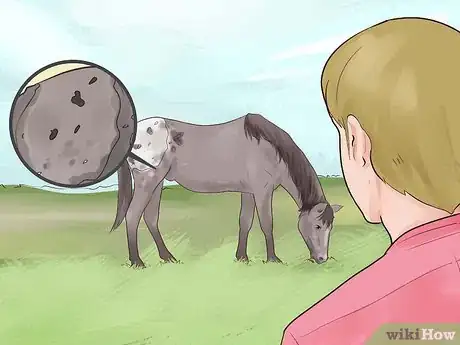
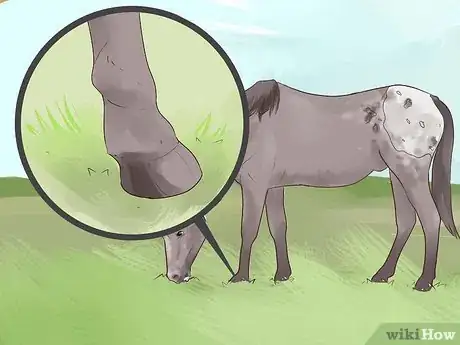
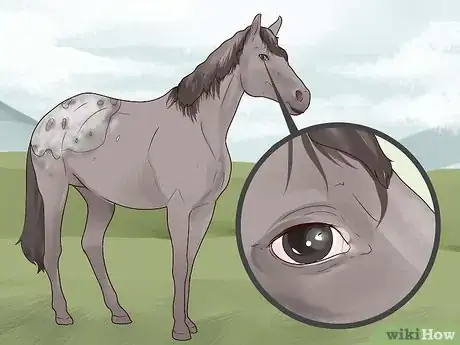
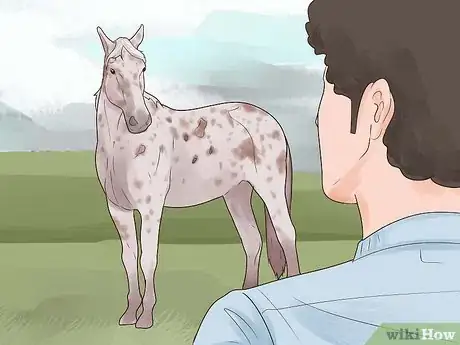
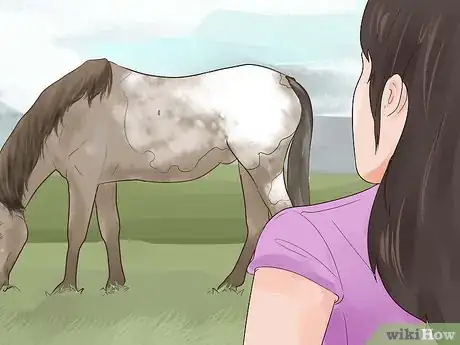
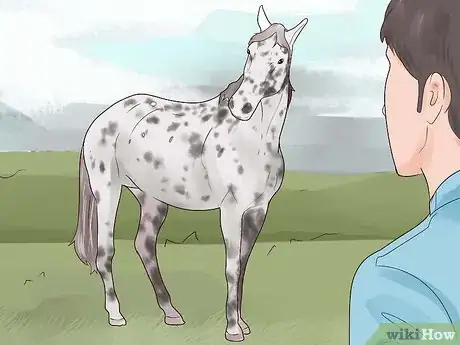


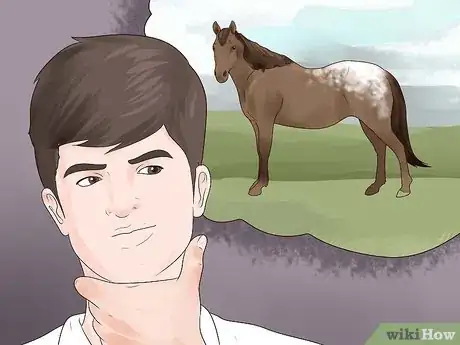
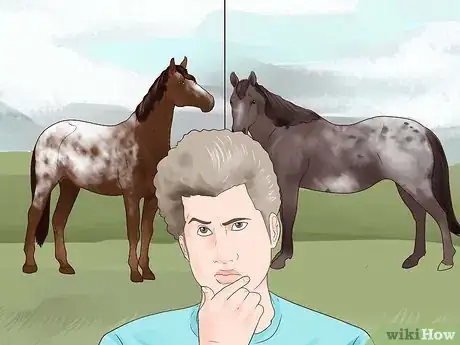

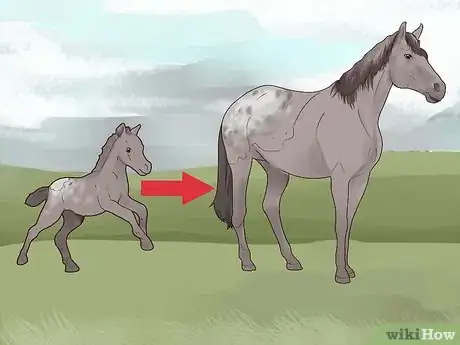
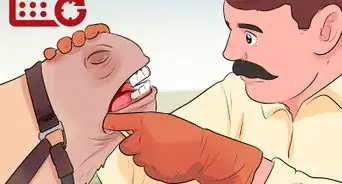
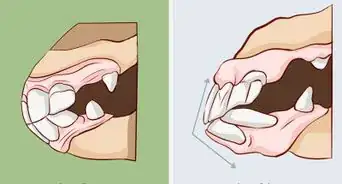
-in-Horses-Step-4-Version-2.webp)
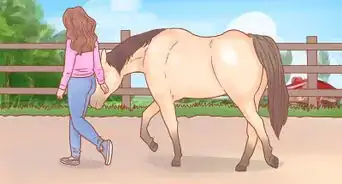



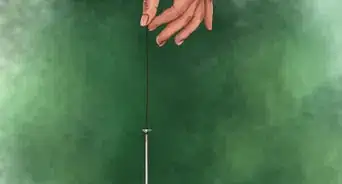


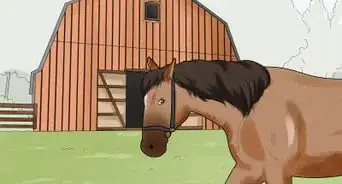
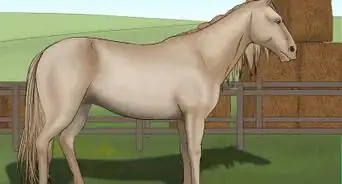
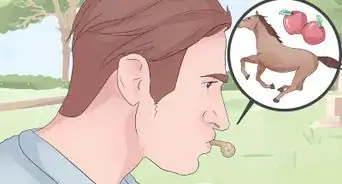








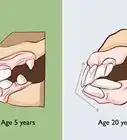

-in-Horses-Step-4-Version-2.webp)


































